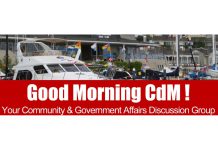
— Photo by Christopher Trela ©
A preliminary look at the Newport Beach Civic Center audit revealed some interesting findings, including a possible overpayment of $1.2 million.
City Council voted 4-3 Tuesday to receive and file the draft audit report and direct city attorney Aaron Harp to pursue the $1.2 million, either by finding documentation to justify the costs or recover the funds. Councilmen Keith Curry, Ed Selich, and Tony Petros dissented.
The draft report presents a lot of areas that are ripe for opportunity for improvement, said Mayor Diane Dixon.
“The report has identified clear problems with the city’s handling of this project,” Dixon said. “there were many oversights and irregularities that could have contributed to the higher cost.”
Vice President of Harris & Associates Allyson Gipson, who was hired to manage the audit, went over the preliminary results of the audit. They are still finalizing the report and waiting for feedback, she noted.
There are still several more conversations to have, information to gather and analysis to do before the final report, Gipson said. This is just a draft report, which is a common practice for a status report, she added.
There were 11 areas council wanted to address in the audit. The focus was primarily to review how it grew in time, cost and scope, review the effectiveness of the process, and analyze the quality of the city’s management of the project, among other topics.
The biggest focus of the two hour discussion was an approximate $1.2 million possible overpayment. The draft audit identifies more than $1.2 million in payments made to C.W. Driver without substantiating documentation to justify the cost expenditures. The lack of clear financial record-keeping on the part of the city and the project manager made the review that much more difficult, Gipson explained.
Those funds could be identified and accounted for, but C.W. Driver simply hasn’t been asked, “What’s the story on the $1.2 million?” Curry said.
“A conversation with (C.W.) Driver is definitely required on the $1.2 million,” noted Derek Hennessey of RW Block Consulting, Inc., the company selected to perform the audit.
But there has been a significant amount of cost review on C.W. Driver’s accounts payable files and that analysis is what drove them to the $1.2 million number, Hennessey explained. After adding up all of C.W. Driver’s accounts payable, they found there was $1.2 paid beyond the allowable cost.
This is the “bottom line” of the report, Curry said.
“Just to put that number in perspective, $1.2 million is about 8/10ths of one percent of the total cost of the project,” Curry said.
Dixon and Mayor Pro Tem Kevin Muldoon suggested moving quickly to recover the potential $1.2 million in overpayment.
“Before we go sending our lawyers off to collect imaginary money that we think people owe us,” Curry said, “what we probably ought to do is give C.W. Driver the opportunity, and our staff the opportunity, to react to the draft.”
The draft report is a “work in process,” Curry said, there hasn’t been enough time for people to respond, react, and provide feedback.
There were specific areas in the report that showed positive results, including that the parking structure was a good value, with the final costs falling well within industry standards for the time period.
Several council members focused on the last few lines of the report, that conclude that the final project costs does not appear to be unreasonable.
“That’s not to say they couldn’t have been lower, but they weren’t unreasonable,” Hennessey said.
Petros emphasized that point, saying that, not forgiving the procurement and document challenges, the project came in at a fair and reasonable cost.
“Even though the project exceeded the original budget, the final cost of the project as it was ultimately designed, was of fair value,” Gipson concluded.
Although Councilman Scott Peotter didn’t exactly agree.
Instead of saying, “We got a lot more for our money,” it should be “We got a lot more and we paid for it,” Peotter noted.
Peotter took the most time of the council members to question the project and process, and highlight flaws or concerns that were raised in the report.
He also asked for a comparison of similar projects.
“There are a lot of components and special features of this building that are unique,” particularly because it’s a public building, which makes it challenging to find anything comparable, Gipson said. She agreed to take a “deeper dive” into the comparison.
Newport Beach Civic Center has the “top of the line of everything,” Peotter said, like windows that open depending on the sun and temperature and floor HVAC.
“It’s like people went through a (check) box and said ‘Which one is the most expensive one? Oh I’ll take that,’” Peotter said.
Several council members also raised concerns about the problems found concerning documentation.
It was difficult to gather all the documents and information from multiple sources, Gipson said. There were also missing, incomplete, and conflicting documents. She noted that several areas could not be evaluated due to insufficient information.
Proper documentation is key, Peotter noted.
“I find it rather embarrassing to have a project of this magnitude and not have the documentation,” he said.
The audit also found that the city’s decision to hire a program manger was a well-advised decision, Gipson said. For a project of this size and complexity, it was a great idea to have an independent expert work with the city, she noted.
However, having the program manager come from the same company as the construction manager is an inherent conflict of interest, she added.
Curry pointed out that the report does note that “based on the documents reviewed, it does not appear the relationship between the Program Manager and Construction Manager at Risk negatively impacted the city in a significant manner.”
Although that language was meant to be removed from the draft report, Hennessey noted, because they wanted people to come to their own conclusions.
The initial conclusion was that they didn’t see any big, clear issues of conflict, he explained, but it could have been better.
Review of the remaining areas raised issues in several key aspects, including lack of budget control, inadequate or missing documentation, and insufficient project oversight by the city.
“This is why you have audits, to find the errors, find the oversights, see where you can change it and find, potentially, if there has been fraud or overpayments, which looks like there might have been overpayments,” Muldoon said.
For future large-scale construction projects, Gipson recommended that the city develop a comprehensive program/project management policies and procedures for how projects will be documented and control and maintained of documents
She also suggested the city clearly determine the roles of participants and level of authority from the outset, establish fiscal controls to direct the level of detail required prior to payment of invoices, conduct periodic performance audits at project milestones, as well as perform close-out audits, and maintain a complete set of project documents.
Several council members said they would like to finish the audit and move on.
“It is what it is, I’m not here to play the blame game, the past is past,” Dixon said. “I’m focused now, as I was at the beginning that lead to commissioning this audit, that there are lessons to be learned.”




